Jan Philip Wahle
SemEval-2025 Task 11: Bridging the Gap in Text-Based Emotion Detection
Mar 10, 2025Abstract:We present our shared task on text-based emotion detection, covering more than 30 languages from seven distinct language families. These languages are predominantly low-resource and spoken across various continents. The data instances are multi-labeled into six emotional classes, with additional datasets in 11 languages annotated for emotion intensity. Participants were asked to predict labels in three tracks: (a) emotion labels in monolingual settings, (b) emotion intensity scores, and (c) emotion labels in cross-lingual settings. The task attracted over 700 participants. We received final submissions from more than 200 teams and 93 system description papers. We report baseline results, as well as findings on the best-performing systems, the most common approaches, and the most effective methods across various tracks and languages. The datasets for this task are publicly available.
Stay Focused: Problem Drift in Multi-Agent Debate
Feb 26, 2025Abstract:Multi-agent debate - multiple instances of large language models discussing problems in turn-based interaction - has shown promise for solving knowledge and reasoning tasks. However, these methods show limitations, particularly when scaling them to longer reasoning chains. In this study, we unveil a new issue of multi-agent debate: discussions drift away from the initial problem over multiple turns. We define this phenomenon as problem drift and quantify its presence across ten tasks (i.e., three generative, three knowledge, three reasoning, and one instruction-following task). To identify the reasons for this issue, we perform a human study with eight experts on discussions suffering from problem drift, who find the most common issues are a lack of progress (35% of cases), low-quality feedback (26% of cases), and a lack of clarity (25% of cases). To systematically address the issue of problem drift, we propose DRIFTJudge, a method based on LLM-as-a-judge, to detect problem drift at test-time. We further propose DRIFTPolicy, a method to mitigate 31% of problem drift cases. Our study can be seen as a first step to understanding a key limitation of multi-agent debate, highlighting pathways for improving their effectiveness in the future.
Voting or Consensus? Decision-Making in Multi-Agent Debate
Feb 26, 2025Abstract:Much of the success of multi-agent debates depends on carefully choosing the right parameters. Among them, the decision-making protocol stands out. Systematic comparison of decision protocols is difficult because studies alter multiple discussion parameters beyond the protocol. So far, it has been largely unknown how decision-making addresses the challenges of different tasks. This work systematically evaluates the impact of seven decision protocols (e.g., majority voting, unanimity consensus). We change only one variable at a time (i.e., decision protocol) to analyze how different methods affect the collaboration between agents and test different protocols on knowledge (MMLU, MMLU-Pro, GPQA) and reasoning datasets (StrategyQA, MuSR, SQuAD 2.0). Our results show that voting protocols improve performance by 13.2% in reasoning tasks and consensus protocols by 2.8% in knowledge tasks over the other decision protocol. Increasing the number of agents improves performance, while more discussion rounds before voting reduces it. To improve decision-making by increasing answer diversity, we propose two new methods, All-Agents Drafting (AAD) and Collective Improvement (CI). Our methods improve task performance by up to 3.3% with AAD and up to 7.4% with CI. This work demonstrates the importance of decision-making in multi-agent debates beyond scaling.
You need to MIMIC to get FAME: Solving Meeting Transcript Scarcity with a Multi-Agent Conversations
Feb 18, 2025Abstract:Meeting summarization suffers from limited high-quality data, mainly due to privacy restrictions and expensive collection processes. We address this gap with FAME, a dataset of 500 meetings in English and 300 in German produced by MIMIC, our new multi-agent meeting synthesis framework that generates meeting transcripts on a given knowledge source by defining psychologically grounded participant profiles, outlining the conversation, and orchestrating a large language model (LLM) debate. A modular post-processing step refines these outputs, mitigating potential repetitiveness and overly formal tones, ensuring coherent, credible dialogues at scale. We also propose a psychologically grounded evaluation framework assessing naturalness, social behavior authenticity, and transcript difficulties. Human assessments show that FAME approximates real-meeting spontaneity (4.5/5 in naturalness), preserves speaker-centric challenges (3/5 in spoken language), and introduces richer information-oriented difficulty (4/5 in difficulty). These findings highlight that FAME is a good and scalable proxy for real-world meeting conditions. It enables new test scenarios for meeting summarization research and other conversation-centric applications in tasks requiring conversation data or simulating social scenarios under behavioral constraints.
BRIGHTER: BRIdging the Gap in Human-Annotated Textual Emotion Recognition Datasets for 28 Languages
Feb 17, 2025Abstract:People worldwide use language in subtle and complex ways to express emotions. While emotion recognition -- an umbrella term for several NLP tasks -- significantly impacts different applications in NLP and other fields, most work in the area is focused on high-resource languages. Therefore, this has led to major disparities in research and proposed solutions, especially for low-resource languages that suffer from the lack of high-quality datasets. In this paper, we present BRIGHTER-- a collection of multilabeled emotion-annotated datasets in 28 different languages. BRIGHTER covers predominantly low-resource languages from Africa, Asia, Eastern Europe, and Latin America, with instances from various domains annotated by fluent speakers. We describe the data collection and annotation processes and the challenges of building these datasets. Then, we report different experimental results for monolingual and crosslingual multi-label emotion identification, as well as intensity-level emotion recognition. We investigate results with and without using LLMs and analyse the large variability in performance across languages and text domains. We show that BRIGHTER datasets are a step towards bridging the gap in text-based emotion recognition and discuss their impact and utility.
CiteAssist: A System for Automated Preprint Citation and BibTeX Generation
Jul 03, 2024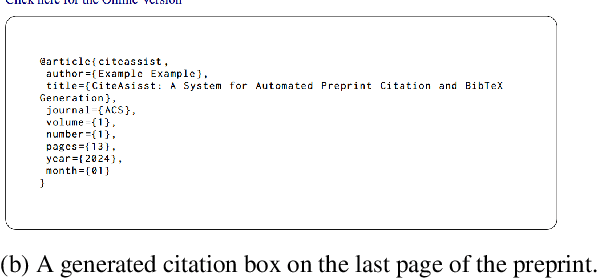
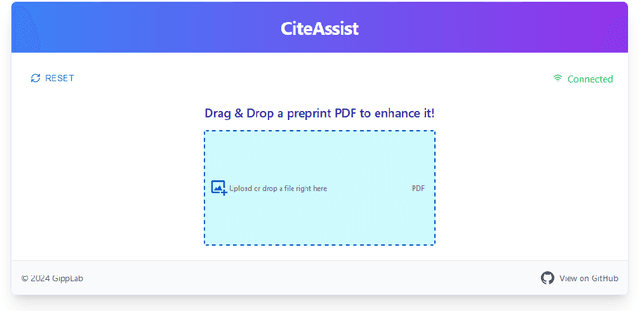
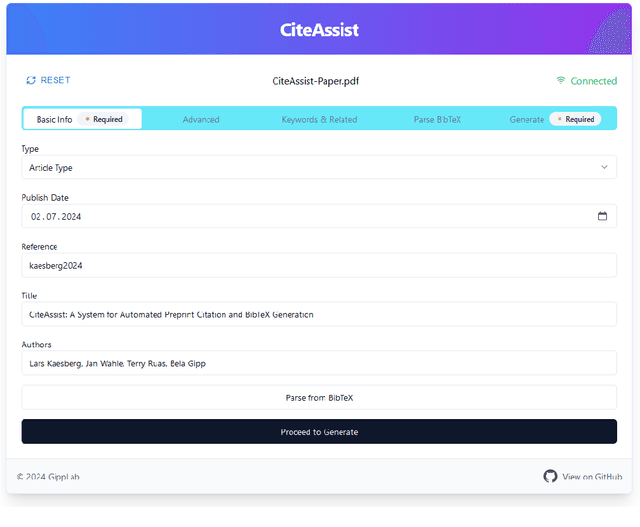
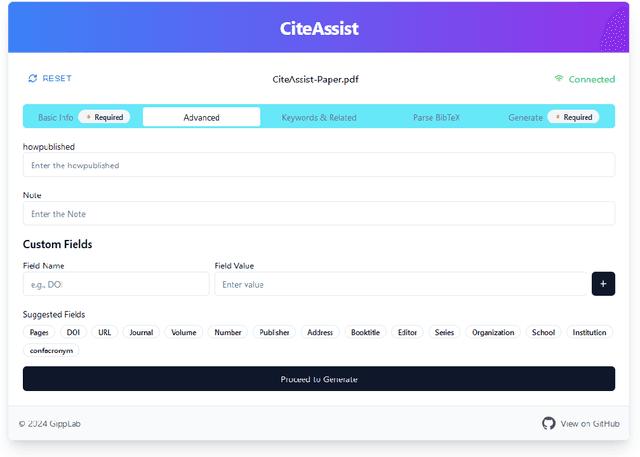
Abstract:We present CiteAssist, a system to automate the generation of BibTeX entries for preprints, streamlining the process of bibliographic annotation. Our system extracts metadata, such as author names, titles, publication dates, and keywords, to create standardized annotations within the document. CiteAssist automatically attaches the BibTeX citation to the end of a PDF and links it on the first page of the document so other researchers gain immediate access to the correct citation of the article. This method promotes platform flexibility by ensuring that annotations remain accessible regardless of the repository used to publish or access the preprint. The annotations remain available even if the preprint is viewed externally to CiteAssist. Additionally, the system adds relevant related papers based on extracted keywords to the preprint, providing researchers with additional publications besides those in related work for further reading. Researchers can enhance their preprints organization and reference management workflows through a free and publicly available web interface.
Towards Human Understanding of Paraphrase Types in ChatGPT
Jul 02, 2024Abstract:Paraphrases represent a human's intuitive ability to understand expressions presented in various different ways. Current paraphrase evaluations of language models primarily use binary approaches, offering limited interpretability of specific text changes. Atomic paraphrase types (APT) decompose paraphrases into different linguistic changes and offer a granular view of the flexibility in linguistic expression (e.g., a shift in syntax or vocabulary used). In this study, we assess the human preferences towards ChatGPT in generating English paraphrases with ten APTs and five prompting techniques. We introduce APTY (Atomic Paraphrase TYpes), a dataset of 500 sentence-level and word-level annotations by 15 annotators. The dataset also provides a human preference ranking of paraphrases with different types that can be used to fine-tune models with RLHF and DPO methods. Our results reveal that ChatGPT can generate simple APTs, such as additions and deletions, but struggle with complex structures (e.g., subordination changes). This study contributes to understanding which aspects of paraphrasing language models have already succeeded at understanding and what remains elusive. In addition, our curated datasets can be used to develop language models with specific linguistic capabilities.
Paraphrase Types Elicit Prompt Engineering Capabilities
Jun 28, 2024Abstract:Much of the success of modern language models depends on finding a suitable prompt to instruct the model. Until now, it has been largely unknown how variations in the linguistic expression of prompts affect these models. This study systematically and empirically evaluates which linguistic features influence models through paraphrase types, i.e., different linguistic changes at particular positions. We measure behavioral changes for five models across 120 tasks and six families of paraphrases (i.e., morphology, syntax, lexicon, lexico-syntax, discourse, and others). We also control for other prompt engineering factors (e.g., prompt length, lexical diversity, and proximity to training data). Our results show a potential for language models to improve tasks when their prompts are adapted in specific paraphrase types (e.g., 6.7% median gain in Mixtral 8x7B; 5.5% in LLaMA 3 8B). In particular, changes in morphology and lexicon, i.e., the vocabulary used, showed promise in improving prompts. These findings contribute to developing more robust language models capable of handling variability in linguistic expression.
CADS: A Systematic Literature Review on the Challenges of Abstractive Dialogue Summarization
Jun 12, 2024



Abstract:Abstractive dialogue summarization is the task of distilling conversations into informative and concise summaries. Although reviews have been conducted on this topic, there is a lack of comprehensive work detailing the challenges of dialogue summarization, unifying the differing understanding of the task, and aligning proposed techniques, datasets, and evaluation metrics with the challenges. This article summarizes the research on Transformer-based abstractive summarization for English dialogues by systematically reviewing 1262 unique research papers published between 2019 and 2024, relying on the Semantic Scholar and DBLP databases. We cover the main challenges present in dialog summarization (i.e., language, structure, comprehension, speaker, salience, and factuality) and link them to corresponding techniques such as graph-based approaches, additional training tasks, and planning strategies, which typically overly rely on BART-based encoder-decoder models. We find that while some challenges, like language, have seen considerable progress, mainly due to training methods, others, such as comprehension, factuality, and salience, remain difficult and hold significant research opportunities. We investigate how these approaches are typically assessed, covering the datasets for the subdomains of dialogue (e.g., meeting, medical), the established automatic metrics and human evaluation approaches for assessing scores and annotator agreement. We observe that only a few datasets span across all subdomains. The ROUGE metric is the most used, while human evaluation is frequently reported without sufficient detail on inner-annotator agreement and annotation guidelines. Additionally, we discuss the possible implications of the recently explored large language models and conclude that despite a potential shift in relevance and difficulty, our described challenge taxonomy remains relevant.
Text Generation: A Systematic Literature Review of Tasks, Evaluation, and Challenges
May 24, 2024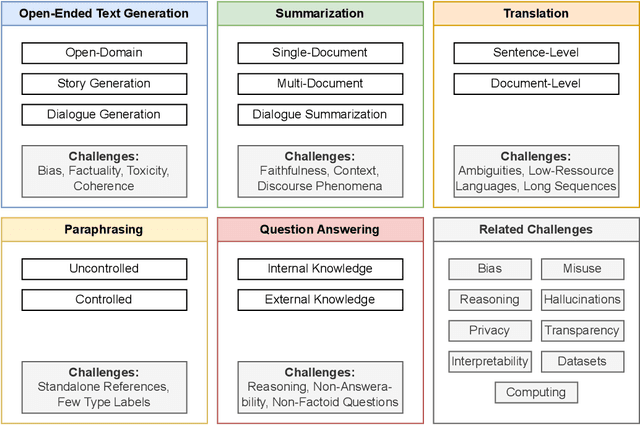


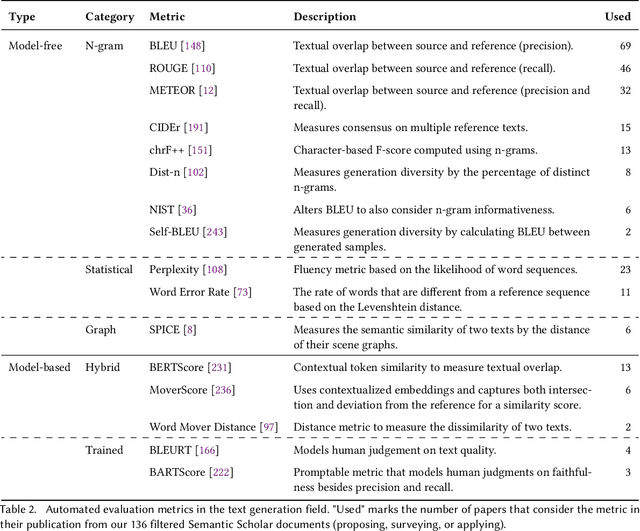
Abstract:Text generation has become more accessible than ever, and the increasing interest in these systems, especially those using large language models, has spurred an increasing number of related publications. We provide a systematic literature review comprising 244 selected papers between 2017 and 2024. This review categorizes works in text generation into five main tasks: open-ended text generation, summarization, translation, paraphrasing, and question answering. For each task, we review their relevant characteristics, sub-tasks, and specific challenges (e.g., missing datasets for multi-document summarization, coherence in story generation, and complex reasoning for question answering). Additionally, we assess current approaches for evaluating text generation systems and ascertain problems with current metrics. Our investigation shows nine prominent challenges common to all tasks and sub-tasks in recent text generation publications: bias, reasoning, hallucinations, misuse, privacy, interpretability, transparency, datasets, and computing. We provide a detailed analysis of these challenges, their potential solutions, and which gaps still require further engagement from the community. This systematic literature review targets two main audiences: early career researchers in natural language processing looking for an overview of the field and promising research directions, as well as experienced researchers seeking a detailed view of tasks, evaluation methodologies, open challenges, and recent mitigation strategies.
 Add to Chrome
Add to Chrome Add to Firefox
Add to Firefox Add to Edge
Add to Edge